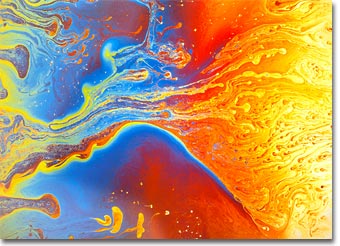Karl E. Deckart
Soap Bubble Gallery: Image One
German photographer and artist Karl E. Deckart is known for his thorough, precise, and beautiful work both in photography through the microscope and with macro camera systems. This gallery of interference photographs made with soap films is a testament to both Deckart's skill as a photographer and his understanding of the physical phenomena that surround our everyday lives. Presented below is soap bubble image number one in small format. Click on the image to download a larger version.

|
Macrophotography of thin soap films freely suspended on a 4 x 4-inch wire frame was conducted with a Linhof large-format bellows camera system utilizing 4 x 5-inch sheet film and imaged using an apo-macro Nikon large format Nikkor-AM ED 210 mm f-5.6 lens. To prepare the soap film, equal parts of water, glycerin, and dishwasher detergent are thoroughly mixed in a container until a solution containing evenly sized micelles is achieved. A freestanding film is formed by dipping the wire frame into the solution and withdrawing carefully to maintain an even film thickness and avoid disruption of material flow across the frame rails. After suspension, the film was illuminated by a reflected light source positioned a few degrees from the camera system. The light was passed through a diffusion screen to avoid bright spots and provide an even illumination across the field. No polarizers were employed in photomacrography of soap thin films. Image ©1999 by Karl E. Deckart. All rights reserved. |
During World War I, shortages of natural fats, a main ingredient of soap, brought about the first serious development of synthetic soap substitutes, and several countries began manufacturing crude detergents. Although household detergent production began in the 1930's, oil and fat supply shortages and rationing of soaps during the Second World War spurred further development of more advanced detergents. Later, post-war Americans bought newly made heavy appliances such as clothes and dish washing machines, which spurred another round of refinement to produce better and cheaper grades of synthetic cleaners. Unlike soaps, detergents do not interact with minerals in water to leave a filmy ring, and have grown to dominate the appliance cleaner market. Experimentation has also led to formulation of milder soaps and shampoos for bathing.
BACK TO THE SOAP BUBBLE GALLERY
